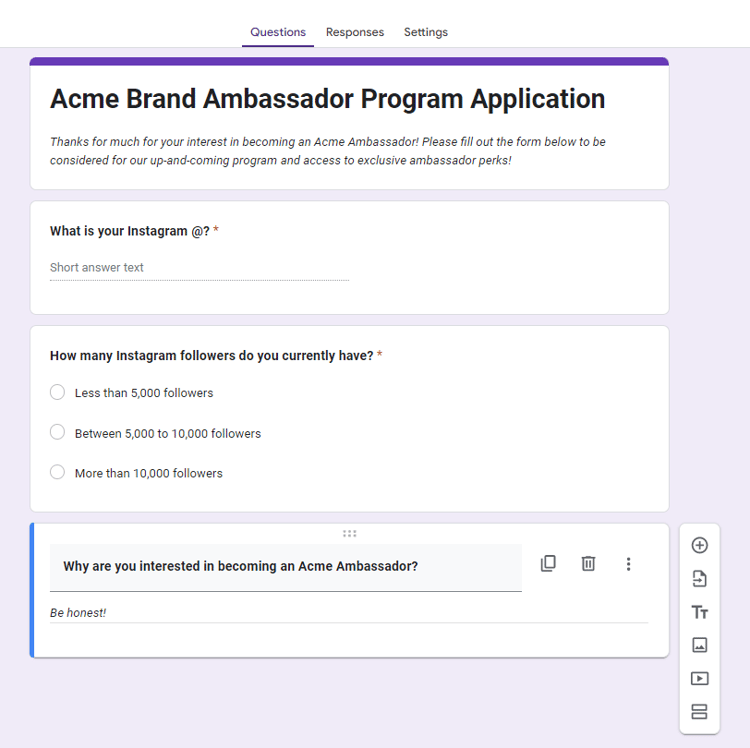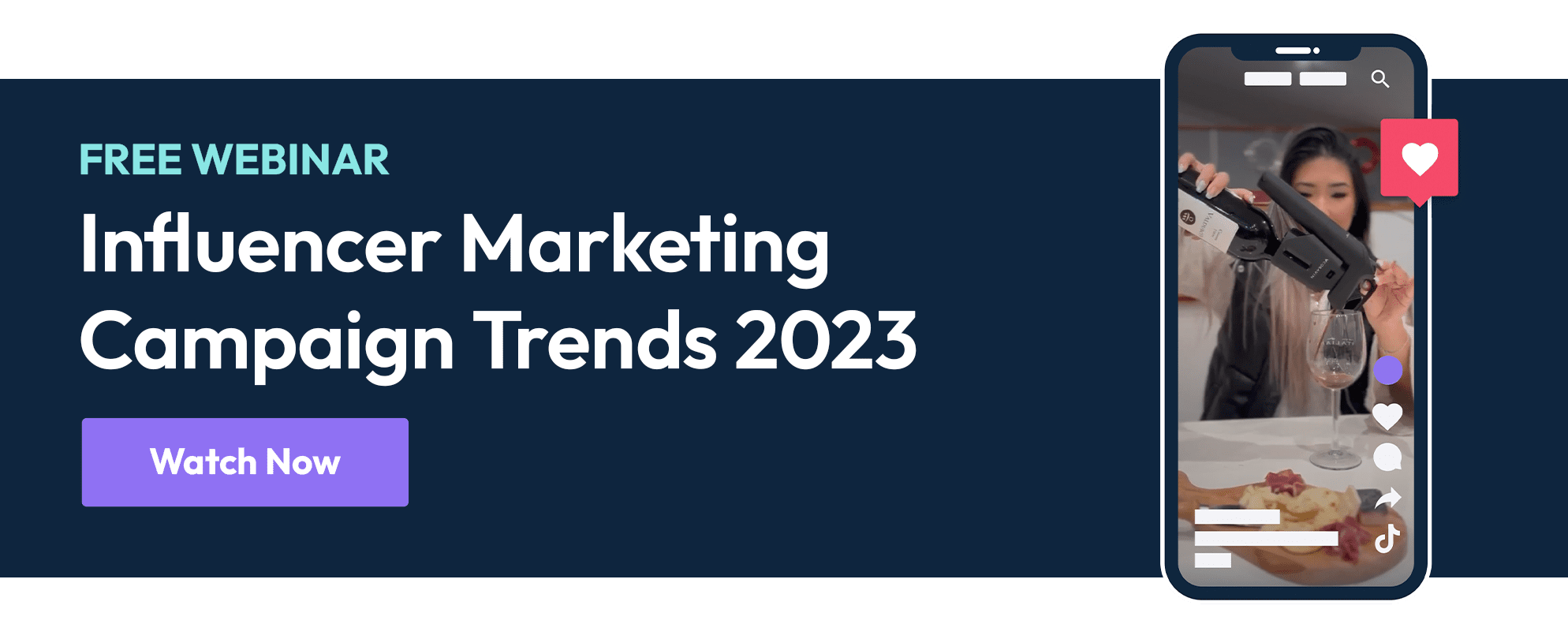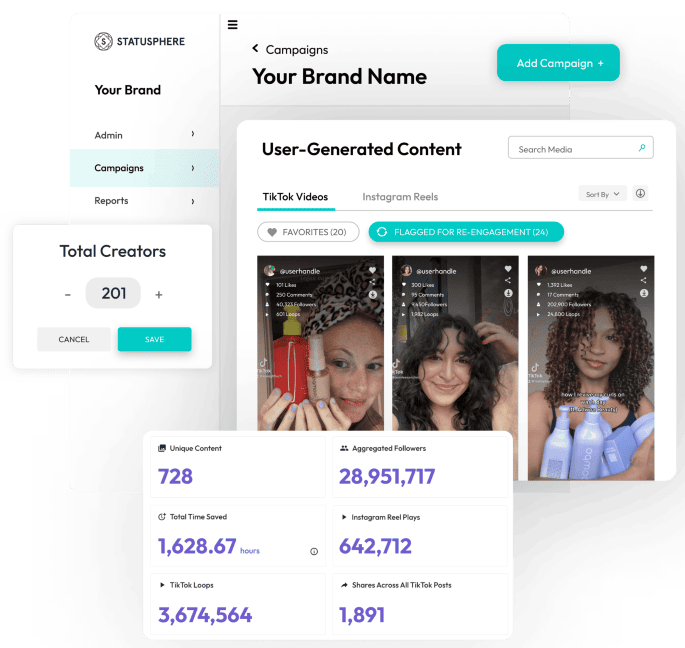4 Popular Types of Brand Ambassador Programs + Examples
Thinking about building a team of brand ambassadors? In this post, we break down the most common types of brand ambassador programs and how they work.
Building a brand ambassador program requires plenty of planning. These ambassador program templates and outlines so you can start growing yours faster.


If you’re thinking about building a brand ambassador program, your head is in the right place.
Because brands today need all the word of mouth they can possibly earn.
Letting your satisfied customers serve as ambassadors on social media is a prime place to start. Especially since Instagram and TikTok are among the top places people discover brands.
There are many types of ambassador programs requiring various levels of legwork. That means you have the flexibility to build a program that works for your team’s bandwidth.
Creating a program from scratch involves a lot of planning regardless of your company's size. That’s why we compiled these brand ambassador program templates and guidelines to help.
Skip to Section 👇The Basics of How to Structure a Brand Ambassador Program 5 Brand Ambassador Program Templates You Can Use |
Before we get into the nitty-gritty, it’s crucial to review the basics of how ambassador programs work. Beyond that, there are a few big-picture points to brainstorm.
Consider the following prior to getting your own program started:
Again, there is no one-size-fits-all brand ambassador program template to stick to. The steps above represent the big picture of any given program.
But the sooner you nail down all of the above, the sooner you can create your program!
Below are five templates and guidelines you can use to plan your program. We encourage you to adapt these outlines to your brand and audience.
This outline maps out the mission of your ambassador program on a high level. After completing this outline, you'll have a clear idea of the next steps to make your program a reality.
Like with influencers, goal-setting guides your ambassador campaigns to have a real impact. There is no “right” answer when it comes to your goals. Many ambassador programs serve to:
Consider establishing a big-picture program goal along with secondary objectives you can measure.
Ex: The primary goals of the [your brand name] ambassador program are as follows:
Many brands run their ambassador programs across multiple social platforms. Some have Instagram or TikTok-exclusive ambassador programs.
The “right” choice depends on your current social presence. Don’t feel pressured to tackle two apps at once. You might consider picking between TikTok and Instagram to avoid spreading yourself thin from the start. After all, can always expand if your program pops off.
Ex: We will run our ambassador program exclusively on [insert social media platform].
If you to attract awesome creators to your program, there needs to be a legit value exchange between you and your ambassadors.
Think about it. A 5% discount isn’t going to drive someone to film a blockbuster video about your products. On the flip side, exclusive discounts and freebies can delight and excite someone enough to create top-tier content about your brand.
In terms of what to offer brand ambassadors, you definitely have options. For example:
Note: regardless of whether you’re compensating with freebies, make sure that you review FTC guidelines to make sure everything’s on the up and up.
In short, you need a game plan for how you’ll actually get people into your program.
This means deciding whether your program will primarily be application-only or invite-only.
There are plenty of ambassador programs that succeed with either approach. Both provide more control over who’s accepted into your program. That said, there’s a bit of a trade-off when it comes to time and resources.
Application-only programs mean that potential ambassadors come to you. This can be a positive or negative depending on your situation. If your inbox is flooded with applicants, sifting through them all is time-consuming. On the flip side, if nobody applies to your program you’ll be forced to conduct outreach anyway.
Invite-only programs obviously require more time and legwork when it comes to tracking down potential ambassadors. Not to mention the back-and-forth involved with outreach and negotiation. While people who apply to an ambassador program clearly show intent, not everyone you reach out to is guaranteed to be interested.
Some brands find a balance by taking a hybrid approach. That is, their program is application-only but exceptions are made for great creators found in the wild.
Keep in mind that you can also pause ambassador applications if you’re ever overwhelmed. For example, popular brands will only accept potential ambassadors during a short-term window. If they need more, they’ll open up applications again.
The good news? Many creators are itching to serve as brand ambassadors to the companies they love. You may be surprised at the positive response to your program’s launch. In the long run, you may not need to recruit aggressively to keep your program up and running.
Management needs really depend on your team’s bandwidth and the type of ambassador program you run.
Regardless, programs require ongoing maintenance and upkeep. For example, you need to delegate tasks and responsibilities such as…
We’ll say it again: building an ambassador program isn’t as simple as it might seem. It’s crucial for brands to know what they’re getting into before they commit.
Note: make sure to craft an approved creator agreement before starting your program!
Food for thought: just because someone is a skilled content creator doesn’t mean they’re a mind-reader. You need to communicate expectations and likewise offer guidance to creators.
List the types of posts you expect your ambassadors to make. Then, consider the resources and time involved on your end to make those posts happen. Here are some common ambassador program content ideas to try:
Chances are you have a vision of what you want your ambassadors’ posts to look like. If so, you’ll need to provide resources and direction. For example:
Just like any other marketing channel, ambassador programs should be data-driven.
Good news: there are plenty of other metrics and KPIs to track. This includes traffic, engagement and how many pieces of content your ambassadors publish. Your priority metrics will be tied to your program’s specific goals.
Ex: We will measure the success of the [insert brand name] ambassador program by tracking changes in the following from quarter to quarter:
Note: Tracking sales from influencers is notoriously tricky, the same applies to most brand ambassador programs. Assuming you plan to provide your ambassadors with discount codes to track their sales, chances are that your numbers will not be 100% accurate. That's why sales by themselves should be the sole way you assess your program's performance.
The initial setup process for an ambassador program is no joke.
Establishing your guidelines. Writing ambassador proposals and contracts. The list goes on.
When in doubt, give yourself some wiggle room to establish a schedule. Rushing your program is a recipe for headaches!
Ex: The [your brand name] ambassador program will launch on [target date or quarter].
Brand ambassador program guidelines vary from business to business. Regardless, you should always review creators thoroughly before partnering with them.
You need to make sure they’re legit and a good fit for your brand. Remember: ambassadors represent an extension of your brand. It’s important to put their accounts and applications under the microscope.
Focus on the following guidelines to start off. The specific numbers and requirements you choose will depend on your brand. That said, having thresholds and established criteria is a huge time-saver. This is especially true if your brand ambassador program is in high demand.
The checklist below mirrors our own best practices for vetting influencers for authenticity.
Remember that follower count alone doesn’t determine the quality of a creator’s content. This applies to brand ambassadors, too. An authentic ambassador with a small following means more than a mega-influencer that’s irrelevant to your target audience.
Still, you should try to prioritize ambassadors that have a sizeable social media presence. A few thousand followers is a fair barrier to entry in most cases.
Your own threshold will depend on the types of creators you want to attract. Some brands will actually provide specific incentives to “bigger” creators. For example, Daniel Wellington offers extra perks for creators with 3,000+ followers.
For reference, we look for an engagement rate between 3.5% and 6% for our creator network. One of the biggest benefits of working with smaller creators is that they typically have more engaged audiences.
Again, numbers alone don’t tell the entire story of a creator’s audience. This is especially given that fake followers are a problem for creators with larger audiences.
How important someone’s engagement rate is to you also depends on your ambassador program goals. For example, you might be more concerned about earning specific types of content versus awareness. If someone ticks all your boxes but their engagement rate is lower than you’d like, you can make an exception for them.
No surprises here! Your ambassadors’ audiences should reflect your audience. When in doubt, comb through their recent followers and comments.
Do the people you see resemble your ideal customers? If so, that’s a good sign.
In short, do they match your brand’s vibe? Do you post the types of content you’re looking for?
Peek their recent posts. Confirm that their style resembles what you’d post on your brand’s feed.
Working with creators who’ve partnered with brands in the past usually means less hand-holding on your part. Onboarding an experienced influencer or UGC creator can save you some serious time. Past experience often yields better content, too.
However, consider which brands someone has partnered with before accepting them. For example, many ambassador program guidelines will explicitly prohibit creators from posting about products from competing brands.
This can become sort of a gray area for creators that promote multiple brands at the same time. When in doubt, it’s fair game to ask. You can make a judgment call from there.
The more a potential ambassador already knows about your product and audience, the better.
Again, satisfied customers make the best brand ambassadors. They already know you and trust you. Likewise, they know your customers because they are one of your customers. This translates to authentic and meaningful content.
This is why it’s a good idea to look for ambassadors who are right under your nose. Someone who frequently tags your brand or shouts out your products organically is a good ambassador candidate by default. Their enthusiasm for your brand can result in awesome posts.
Below is a list of questions to ask potential brand ambassadors. You might notice that some ambassador questionnaires and application forms are surprisingly short. Others are in-depth.
If you’re only looking for a handful of ambassadors, you can afford to be picky. Still, you want to respect the time of your potential ambassadors. You likewise don’t want to have to sift through a novel’s worth of information for each applicant.
But on the flip side, forms that are too short can lead to low-effort applications and spam.
A combination of single-answer questions and open-ended questions is a good balance. We recommend finishing an ambassador application template that lets you include both.
For example, many brands use Google Forms which makes it a cinch to combine multiple types of brand ambassador questions. Below is an example of a mock-up form we made. Beyond Google, there are influencer intake tools that offer pre-built brand ambassador application forms.

With that out of the way, below are some examples of questions to ask potential ambassadors.
Note: you don’t need to use all of these on your questionnaire! Just the most relevant ones.
Open-ended Questions 📄Why do you think you’d be a good ambassador for [insert brand name]? In your own words, please describe your social media audience and goals. How would you describe your personal brand? How do you learn about our ambassador program? Share a recent social media post that highlights your personal brand (link or upload). |
These questions offer potential ambassadors a chance to elaborate on their experience. Also, their answers can give you a better sense of their personality and who they are. This can help you decide more definitively whether they’re a good fit. Not to mention potential red flags.
Closed-ended and Single-answer Questions 📄What is your @handle on [insert social media platform]? How many followers do you have on [insert social media platform]? Which platforms are you currently active on? (check all that apply) Please list any brands you’ve partnered with in the past. Do you currently follow [insert your brand name] on [insert social platform]? How many times per month do you post about brands on [insert social platform]? |
These direct questions can really qualify (or disqualify!) potential brand ambassadors faster. Some might seem like no-brainers but a lot of forms leave them out.
Outreach is a proactive way to get your program up and running faster.
Even if your program is application-only, having invitation templates on deck is a good idea. You might come across a creator that’d be awesome for your program but hasn’t applied yet. A little nudge via email can do the trick.
Below is an ambassador pitch template you can send via email or DM. For context, this particular message is tailored toward TikTok ambassadors.
|
Hi [insert creator's name], I’m [insert your name] with [insert brand name]. We're reaching out because your recent post on [insert social platform] caught our attention. Our team appreciates the effort and creativity that goes into your [insert topic] videos. We’ll cut to the chase: we’d love to invite you to become a [insert brand name] ambassador! We think your [insert what you saw on their feed that aligns with your company’s values] would really resonate with [brand name]’s audience. As a brand ambassador, you would partner with us to [insert a summary of your ambassador program's mission]. In exchange, you’ll earn [insert your program’s perks and value proposition here]. I'd love to share our program’s perks and what we have to offer! If you’re interested, please DM me back or email me at [insert email address]. Thanks! [Insert your email signature] |
From subject lines to where you send your messages, creator outreach involves a lot of moving pieces. Check out our posts about pitching brand ambassadors on Instagram and TikTok for more tips and best practices.
This template serves as a warm welcome to someone who’s been accepted into your ambassador program.
Note: This template assumes you have an official creator agreement ready. The same goes for an on-site acknowledgment of the legal requirements of your program. Make sure to get those squared away and talk to your legal team before you kick your program off!
|
Hey [insert creator's name], It’s official — we’re thrilled to officially welcome you to the [your brand name] ambassador program! To quickly recap, being a [your brand name] ambassador means that you:
We hope you’re as excited as we are to work together! Before we kick things off, we ask that you do the following:
Once all that’s squared away, we’ll kick things off by [insert next steps]. If you have any questions regarding this email or the program, please let us know! You can respond to this message or email [insert point of contact] at [insert point of contact’s email address]. Thanks! [insert your email signature] |

Whew! Hopefully, these templates and guidelines can help your program get started faster. In addition to the points above (we know it’s a lot!) here are a few more things to consider:
There’s no denying that ambassador programs involve a lot of ongoing time and energy.
This explains why many brands turn to influencer marketing as means of earning social proof and authentic content.
Because influencers are so much more time-efficient and scalable versus a DIY ambassador program. Granted you're using a platform like Statusphere.
Our micro-influencer software matches brands with vetted influencers from our creator community using 250+ first-party data points. Unlike other platforms, we help brands earn a high volume of guaranteed content long-term.

Statusphere also eliminates the most time-consuming pieces of working with influencers in-house thanks to our advanced matchmaking and fulfillment technology. We’ve already generated 75,000+ pieces of content for 400+ consumer brands.
Want to see how our platform works? Get in touch with one of our experts to learn how we can optimize your brand’s influencer marketing in a fraction of the time.
This article was first published in July 2020. It was last updated May 7, 2023.
Thinking about building a team of brand ambassadors? In this post, we break down the most common types of brand ambassador programs and how they work.
A brand ambassador program is a solid way to get people chatting about your company and what it has to offer. These programs typically come from...
Trying to understand the difference between affiliate and ambassador programs? This guide breaks down everything brands should know about how both...
Be the first to know about the latest tools, trends and strategies in influencer marketing for brands.